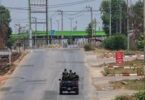Monitoring Desk
PARIS: The University of Bristol’s Smart Internet Lab led the team behind the 5G-enabled Tourism Experience Catalyst project that will be showcased at this year’s Digital Transformation World in Nice, France [Tuesday 14 – Thursday 16 May].
The aim of the TMF Catalyst program is to bring together buyers and end users with solutions and technology providers from across the media and telco space to collaboratively develop proof-of-concept projects. These rapid-fire projects focus on driving technical innovation to build demonstrable solutions to solve industry challenges.
The team, led by Bristol’s Smart Internet Lab, brought together other key members of the UK Government’s 5G Testbeds and Trials ‘5G Smart Tourism’ project – Cambridge Communications Systems Ltd and Zeetta Networks Ltd – as well as the creative might of BBC R&D and Oscar-winning Aardman animations.
The result was the 5G-enabled Tourism Experience Catalyst project – a truly ground-breaking, advanced proof-of-concept, allowing visitors to immerse themselves in history using a virtual reality (VR)/augmented reality (AR) application enabled by 5G network technology. Using consumer devices, visitors are able to ‘see’ back in time at one of the UK’s most popular tourist attractions, The Roman Baths. Such innovations are increasingly important for a market that is worth an estimated US$32bn to the UK and US$7.6tr globally.
As Catalyst leader, the University of Bristol’s Smart Internet lab was responsible for the technical architecture and the use-cases or applications.
Professor DimitraSimeonidou, Director of the Smart Internet Lab at the University of Bristol, said: “5G offers high bandwidth, low latency and edge computing and will transform our future digital society and economy, impacting key sectors, including: transport, health , education, manufacturing, and in this occasion, tourism. The University’s Smart Internet Lab has pioneered research on 5G technologies, and experiments on its 5GUK Test Network, the UK’s first urban 5G End-to-End Testbed, delivering international and national impact.”
Mobile Heritage Virtual Reality Location application
Virtual Reality (VR) and Augmented Reality (AR) are two of the most demanding use cases for 5G. BBC R&D and Oscar winners Aardman have developed an augmented reality application that provides complex overlays and animations that help to bring to life the ruins of the Roman Baths in Bath, UK. The Mobile Heritage Virtual Reality Location application helps people understand and appreciate the history of a heritage site.
Chloe Barraclough, Interactive Producer at Aardman, added: “We love exploring new ways to bring stories to life through emerging technologies, pushing creative boundaries that celebrate the craft, humour and storytelling that Aardman are famous for. Not least the Roman Baths 5G AR application where we produced beautiful 3D models of the building and its incredible history that were put to the test through advanced 5G technologies.”.
Graham Thomas Section Head for Immersive and Interactive Content of BBC R&D, explained: “BBC R&D is exploring how to create and deliver new kinds of content to delight our audiences. This project has shown us how 5G can enable delivery of visually-rich VR/AR content to users, taking advantage of features such as mobile edge computing.”
Network Slicing, MEC and Millimetre Wave (mmWave)
The Heritage application is enabled by a 5G network which uses unique capabilities such as network slicing, low latency and MEC to deliver a resilient service tailored for high-volume tourism scenarios. Cambridge Communication Systems (CCS) use millimetre wave (mmWave) wireless radios to provide very high bandwidth, high-speed connections that enable MEC. Zeetta Networks provides network control and a sliced network environment that segregates and protects the demands of complex services. The full capability will be demonstrated at IBC 2019 in September.
Martin Harriman, CCS Executive Chairman, said: “CCS’s MetnetmmWave access and backhaul technology has been central to the successful delivery of the 5G Smart Tourism trial in Bristol and Bath, and we are now demonstrating the wider potential of these capabilities in this new Visitor Experience Catalyst. Working with an exceptional team of partners, we are highlighting exactly what this collaborative approach can deliver in terms of 5G innovation and performance, and providing a really outstanding showcase for exciting, immersive services for mobile users.”
VassilisSeferedis CEO of Zeetta Networks, added: “Anyone who has tried to use a smartphone in a crowded location has experienced the impact of congestion on mobile (4G/LTE) and Wi-Fi networks. Many applications also have a detrimental effect on battery life. The catalyst demonstrates why 5G, with its ability to support huge numbers of connected devices, and mobile edge computing, which offloads power-hungry processing, is essential for a good visitor experience. This Catalyst exceeds the capabilities of existing networks and proves the need for 5G in tourism.”
Extension of the catalyst at IBC 2019
The catalyst consortium will continue to develop the capabilities of the proof-of-concept. At IBC2019 as well as the Mobile Heritage application, the team will demonstrate an important Public Safety capability using an incident area network (IAN) as well as enhancing the millimetre wave, network slicing and deployable enterprise networks.
Courtesy: (bristol.ac.uk)






